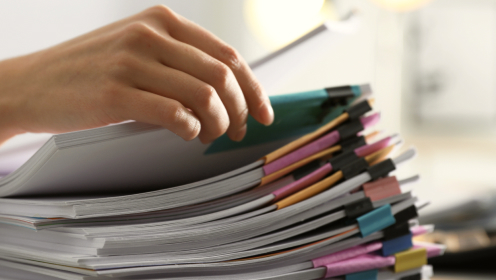Restaurant Accounting Formulas
For involved restaurant managers – those associates REALLY involved in their establishment’s day-to-day operations – there’s nothing quite like getting into the weeds for some deep financial analysis.
And these types of detailed assessments are next to impossible without restaurant accounting formulas.
From cost of goods sold (COGS) to gross profit to labor cost percentage and dozens of other restaurant formulas, the accounting experts here at RASI compiled some of the most widely-used – and useful – restaurant accounting formulas to know.
Whether you’re looking to trim costs, identify deficiencies within your operation, or simply know a little more about how your restaurant utilizes labor, pays bills, serves customers and ultimately makes money, it’s helpful to know the following restaurant accounting formulas, at a minimum.

Fair warning: many of the terms below are a bit complex in nature, but we’ve simplified some of the more abstract theories to present these restaurant formulas in a digestible (always relevant in the restaurant industry) format.
So without further ado, let’s “nerd out” a bit and give you a rundown of the most essential, gotta-know-em, can’t-do-without restaurant accounting formulas!
B
Balance Sheet
Assets = Liabilities + Owner’s Equity
Assets = represent items of value that a company owns and has in its possession or something that will be received and can be measured objectively
Liabilities = something a person or company owes, usually a sum of money
Owner’s Equity = represents the value of funds shareholders invested in the company
Learn how to create a balance sheet with our helpful article!
Break-Even Point
Total Fixed Costs / [(Total Sales – Total Variable Costs) / Total Sales] = Break-Even Point
C
Cost of Goods Sold Formula
(Opening Inventory + Purchases – Credits – Ending Inventory ) / Sales = COGs
Opening Inventory = the inventory at the start of the period you’re looking at within your financial statements (if weekly, it’s the beginning of the week…if monthly or period, it’s the beginning of the month or period)
Purchases = these are the purchases that you make during the accounting period
Ending Inventory = the dollar amount of inventory you have left on your shelves at the end of the accounting period or at the end of the week
Sales = to evaluate the cost as a percentage of your sales, divide the dollar amount above into your sales
Still wondering how to calculate COGS? Use the COGs Calculator and plug in your own numbers.
Cash Flow Break-Even
A cash flow breakeven not only factors in your restaurant profitability but also your debt servicing, government assistance, and anything else that does not show up on your P&L but needs to be factored into your cash management strategy.
Contribution Margin
Selling Price – Cost of Ingredients = Contribution Margin
D
Daily Capacity
# of Tables x # of Seats x # of Table Turns x $ Avg. Tickey = Daily Capacity
E
Earning Before Interest, Taxes, Depreciation, and Amortization (EBITDA)
Operating Profit + Amortization Expense + Depreciation Expense = EBITDA
OR
Net Income + Interest + Taxes + Depreciation + Amortization = EBITDA
F
Food Cost
Beginning Food Inventory + Food Purchases – Ending Food Inventory / Food Sales = Food Cost
Food Cost Percentage
Item Cost / Selling Price = Food Cost Percentage
Check out our Food Cost Percentage Calculator to calculate your restaurant’s food cost percentage.
G
Gross Profit
Gross Profit = (Total Sales – COGS)
Gross Profit Margin = [(Gross Profit / Sales) x 100]
Gross Profit After Prime Costs (GPPC)
Gross Profit = (Total Sales – COGS – Labor Cost)
I
Inventory Turnover Ratio (ITR)
COGS / [(Beginning Inventory + Ending Inventory)/ 2] = Inventory Turnover
L
Liquor Cost Formula
(BI + P – EI) / S = PC or COGS
BI = Beginning Inventory – what you had on the shield at the beginning of the week
P = Purchases – what product you’ve purchased this week
EI = Ending Inventory – what product you still have at the end of the week
S = Sales – the dollar amount that you’ve sold throughout the week
PC = Pour Cost (or Liquor Cost) – your product usage
Check out the liquor cost calculator and use your own numbers!
Labor Cost
Total Hourly Labor / Gross Sales = Labor Cost
Labor Cost Percentage
Labor / Sales = Labor Cost Percentage
N
Net Profit
Net Profit = [(Total Food/Bev Sales + Non-Food/Bev Sales) – Expenses]
Net Profit Margin = [(Net Profit / Revenue) x 100]
Net Profit Margin
(Gross Sales – Operating Expenses) / Gross Sales = Net Profit Margin
OR
Net Income / Gross Sales = Net Profit Margin
Net Income
Gross Revenue – Operating Expenses = Net Income
P
Payroll Percentage
Total Payroll Costs / Total Revenue = Restaurant Payroll Percentage
Still wondering how to calculate payroll percentage? Check out our article and payroll percentage calculator.
Prime Cost
Prime Cost = Total COGS + Total Labor
Prime Cost as a Percentage of Sales = Prime Cost ÷ Total Sales
Use your own number with the Prime Cost Calculator.
Profit Margin
Gross Profit Margin = [(Revenue – COGS)/Revenue]*100
Net Profit Margin = [(Revenue – ALL Costs)/Revenue]*100
T
Table Turnover
# of Guests Served / Number of Seats = Table Turn Time
*# of Guests Served must be over a specific, determined time period.




